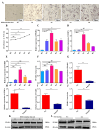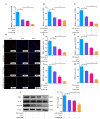NDUFAB1 as a Novel Regulator of NEFA-Induced Metabolic Dysfunction in Bovine Adipocytes
- PMID: 40509084
- PMCID: PMC12153833
- DOI: 10.3390/ani15111618
NDUFAB1 as a Novel Regulator of NEFA-Induced Metabolic Dysfunction in Bovine Adipocytes
Abstract
Elevated non-esterified fatty acid (NEFA) levels are closely associated with metabolic disorders in dairy cattle, yet their direct effects on adipocyte physiology remain poorly understood. In this study, we demonstrate that high NEFA concentrations significantly impair bovine adipocyte function by simultaneously inhibiting proliferation/differentiation (p < 0.01) and promoting pathological lipid deposition. Through integrated transcriptomic and functional analyses, we identified NDUFAB1 as a central metabolic regulator that counteracts NEFA-induced adipocyte dysfunction. Mechanistically, NDUFAB1 activation attenuates the cytotoxic effects of excessive NEFA exposure. These findings provide both fundamental insights into energy metabolism regulation and a potential therapeutic target (NDUFAB1) for preventing bovine metabolic diseases.
Keywords: NDUFAB1; NEFA; adipocyte; bovine; metabolic dysfunction.
Conflict of interest statement
The authors declare that the research was conducted in the absence of any commercial or financial relationships that could be construed as a potential conflict of interest.
Figures








References
-
- Pathmaperuma A.N., Mana P., Cheung S.N., Kugathas K., Josiah A., Koina M.E., Broomfield A., Delghingaro-Augusto V., Ellwood D.A., Dahlstrom J.E., et al. Fatty acids alter glycerolipid metabolism and induce lipid droplet formation, syncytialisation and cytokine production in human trophoblasts with minimal glucose effect or interaction. Placenta. 2010;31:230–239. doi: 10.1016/j.placenta.2009.12.013. - DOI - PubMed
Grants and funding
- 2021YFYZ0001/Key R&D Program of Sichuan Province
- 32202670/National Natural Science Foundation of China Youth Science Foundation Project
- SCCXTD-2024-13/Sichuan Innovation Team of national modern agricultural industry technology system
- kczx2023-2025-02/Ya'an City Establishes National Modern Agriculture Industry Technology Innovation Center "Leading the Charge" project
LinkOut - more resources
Full Text Sources

